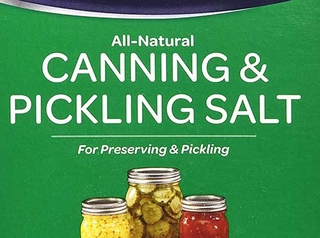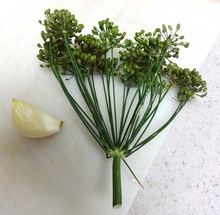Quick facts
- Only use food-grade 5% acidity vinegar for home canning.
- Don't use homemade vinegar when you make pickles because the acetic acid content is unknown and variable.
- Don’t use vinegars that have very high acidity (10-75%) such as cleaning or agricultural vinegars for any food processing. These vinegars may contain solvents and other components that make them unsafe for use in food.
- Learn more about vinegar.
Other ingredients
Vinegar is the preservative and flavoring agent in most pickles. What kind you use depends on the color and flavor you want to have in the pickled product.
Some points to remember:
- Do not change the proportions of vinegar, cucumber or water in the recipe you use.
- Never use vinegar with unknown acidity. Check the vinegar label and look for vinegar that contains 5% acetic acid.
- Do not dilute vinegar unless the recipe specifies. The vinegar prevents botulism.
- Some very old recipes were based on a pickling vinegar of 10% strength. Using today's 5% vinegar in an old recipe that called for a 10% acid vinegar can possibly lead to an unsafe product because of the lower acid content. Look for a recipe that provides the correct proportions of 5% vinegar, cucumbers and water.
- The ratio of vinegar to water varies by the vegetable; again select a recipe for the vegetable you are pickling.
- Some vegetables such as onions, mushrooms and artichokes are pickled in straight 5% vinegar with no additional water.
Most pickle recipes call for distilled white vinegar. This is the clear, colorless vinegar made by fermenting grains. It has a mellow aroma, tart acid flavor and does not affect the color of light-colored vegetables or fruits.
Apple cider vinegar
Apple cider vinegar made from fermented apple juice is a good choice for many pickles. It has a mellow, fruity flavor that blends well with spices. But it will darken most vegetables and fruits. Cider vinegar may be substituted for white vinegar of the same acidity.
Apple cider-flavored distilled vinegar
Apple cider-flavored distilled vinegar has the flavor and brown color of apple cider vinegar, but it is a mixture of apple cider flavoring and distilled vinegar. Use it in the same way as apple cider vinegar.
Don't use other kinds of vinegar unless you're sure of the acid content
The three vinegars listed above contain 5 percent acetic acid and are found in the food sections of grocery stores. Occasionally you will find 3 and 4 percent acetic acid vinegars. These might be called salad vinegar and are not strong enough to make good quality or safe pickles for home canning.
Very high-acid vinegars have become more widely available with acidity levels as high as 15%-75%. They may or may not be labeled "cleaning vinegar" or "agricultural vinegar." These vinegars may contain solvents and other components that make them unsafe for use in food.
- Don't use vinegar for home canning unless you are sure of its acetic acid content. It should be 5%.
- Don't use homemade vinegar when you make pickles because the acetic acid content is unknown and variable.
- Only use a 5% acid vinegar found in the food aisle of your local grocery stores.
Be safe and enjoy!
Canning salt
Use pickling or canning salt without iodine or anti-caking agents. Other salts contain anti-caking materials that may make the brine dark and cloudy.
Sugar
Use white sugar unless the recipe calls for brown sugar. If you plan to use a sugar substitute, follow recipes developed for these products.
Spices
Use fresh whole spices for the best quality and flavor in pickles. Powdered spices may cause the product to darken and become cloudy.
Dill
Dill is often added to each jar before adding the brine. Use clean, fresh, insect-free heads of dill. Avoid over-mature, dry, brown dill. Frozen dill may be used if stored in airtight containers, but flavor loss or change may occur. Add 1 whole head per pint or 1.5 heads per quart. You can substitute 1 tablespoon of dill seed for 1 dill head if needed.
Garlic
Garlic is often added to each jar before adding the brine. Only use the amount of garlic indicated in your recipe. Adding more garlic or other low-acid foods like hot peppers can make the product unsafe.
The water you use may affect the final product. Use soft, distilled or filtered water when possible to avoid a cloudy brine. Hard water can interfere with the formation of acid and prevent pickles from curing properly. Water with above-average calcium content can shrivel pickles, and iron compounds can make them darker than normal.
To soften hard water, boil for 15 minutes and let it sit undisturbed for 24 hours and discard sediment. Add 1 tablespoon vinegar per gallon of water before using.
Chlorine in municipal water does not negatively impact the quality of the final product.
Can I reuse pickling brine?
According to a National Center for Home Preservation blog post on drying, you can save and reuse pickling brine (vinegar, salt, sugar, water solution) if it was not combined with the vegetables you are pickling. But do not reuse brine mixed with vegetables. The vegetables soak up the vinegar solution making them acidic while making the pickling solution less acidic. For safety's sake, do not use leftover brine that previously held vegetables for another recipe. Remember, fresh is always best.
If you use up-to-date, tested recipes and fresh quality produce, firming agents are unnecessary. But some home canners still like to use firming agents when making pickles. Let’s review some common firming agents.
Ice water
One of the simplest methods of firming pickles is to use ice. Soak cucumbers or other vegetables in ice water or layer with crushed ice for 4 to 5 hours before pickling. Sometimes this step is combined with a salt solution indicated by the recipe.
Alum
Alum does not improve the firmness of fresh-pack pickles. Alum is a compound used in old recipes to make pickles crisp. It is no longer recommended by the FDA and current science-based recipes no longer include it. If ingested in large quantities, it can produce nausea or severe distress in the digestive system.
Calcium chloride
Calcium chloride is a safer alternative to pickling lime and has become available to home canners as Pickle Crisp® by Ball or Xtra Crunch® by Mrs. Wages. These products offer fast results with the same great taste and crispness of lime. They do not have the hydroxide component of lime, so they don't lower the acidity of pickled food or pose a food safety risk. A small amount is added to each jar of pickles before sealing the jar with a lid. Be sure to follow the manufacturer’s directions.
Calcium chloride may leave a bit of a salty taste but adds no sodium. These products have an indefinite shelf life but will clump and become hard when exposed to humidity, so it is important to keep them in as dry conditions as possible.
Commercial canners and food entrepreneurs use calcium chloride as an alternative to removing the blossom end.
Grape leaves
Grape leaves contain tannins to inhibit the enzyme that makes pickles soft. Cutting off the blossom end 1/16th of an inch of each cucumber has the same effect as grape leaves.
Lime
The calcium in lime (Calcium hydroxide) improves pickle firmness, but food-grade lime must be used when making a limewater solution for soaking fresh cucumbers. This is done 12-24 hours before pickling.
But excess lime neutralizes or removes acidity and so must be completely washed out to make safe pickles. To do this, drain the limewater solution, rinse and then re-soak the cucumbers in fresh water for 1 hour. Repeat the rinsing and soaking steps two more times. The lime treatment is recommended only for specific USDA-tested recipes.
If using lime (calcium hydroxide) follow these safety guidelines:
- Handle carefully. Follow the manufacturer's instructions for safe handling.
- Do not inhale or expose the lime dust to the eyes.
- Accidental ingestion can cause burns of the throat and esophagus.
Reviewed in 2023




